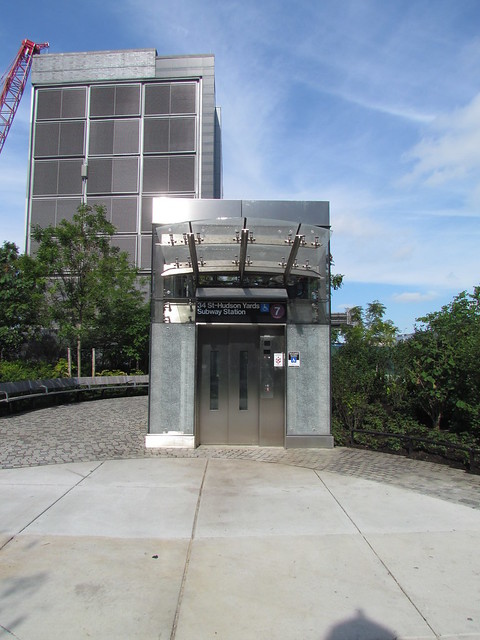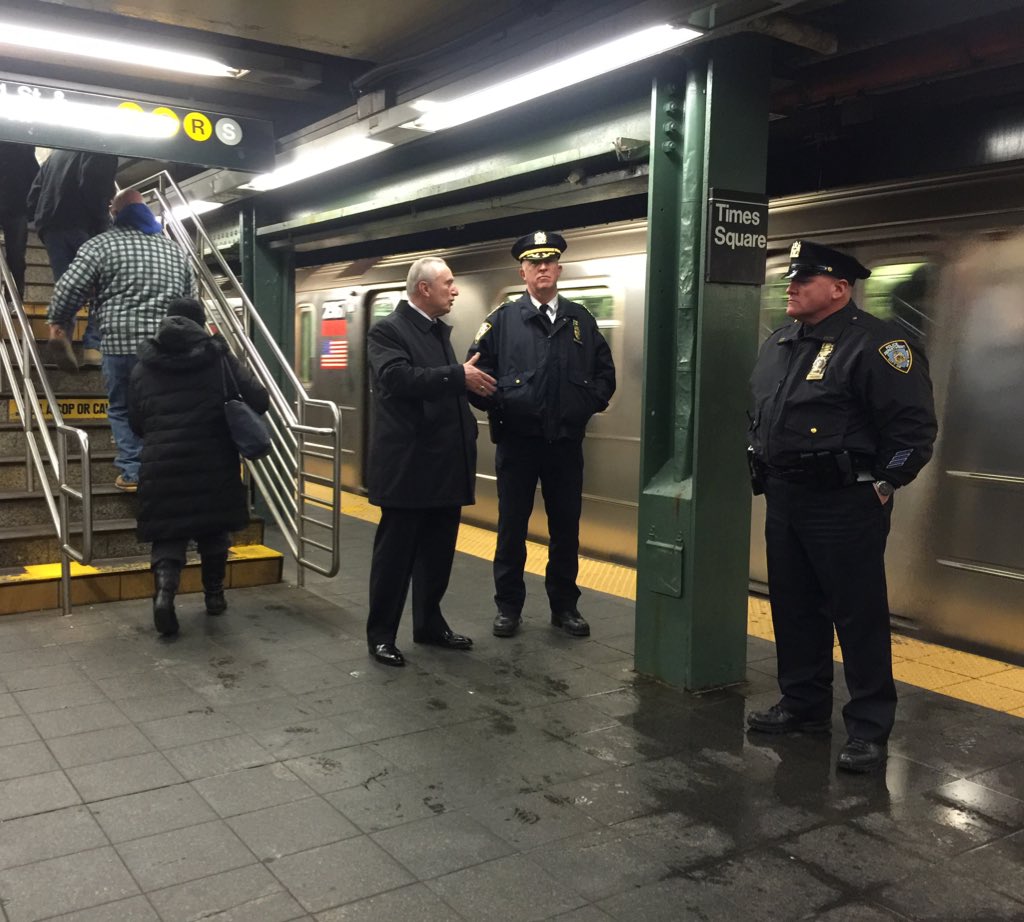
This rendering shows the proposed Brooklyn-Queens streetcar passing Industry City. (Friends of the Brooklyn Queens Connector)
Mayor Bill de Blasio, in his State of the City speech, is set to announce support for a $2.5 billion plan to build a light rail that would connect the rapidly developing Brooklyn and Queens waterfront areas. The proposal, developed over the past six months by a group of real estate developers, transportation advocates and urban planners calling itself the Friends of the Brooklyn Queens Connector, aims to provide better transit options for job centers in Industry City, Red Hook and the Brooklyn Navy Yards while easing the north-south connections between Astoria, Long Island City and parts south throughout Brooklyn. It is not a slam-dunk proposal from a transit perspective, and the city will have to make the case that it is a sound investment considering the city’s competing needs.
We learned about the plan, in fairly specific detail, a few weeks ago when initial studies were leaked to the press, and on Wednesday, Michael Grynbaum of The Times broke news the streetcar would be a headliner during de Blasio’s speech. He wrote:
The plan, to be unveiled on Thursday in the mayor’s State of the City speech, calls for a line that runs aboveground on rails embedded in public roadways and flows alongside automobile traffic — a sleeker and nimbler version of San Francisco’s trolleys…The streetcar system, which would realize a long-held fantasy of the city’s urban planners, is expected to cost about $2.5 billion, significantly less than a new underground subway line, city officials said on Wednesday.
Its operation, however, remains far-off. Under the plan, construction would start in 2019, after studies and community review; service would begin several years after that, perhaps not until 2024, officials said. Alicia Glen, the deputy mayor for housing and economic development, acknowledged “some significant engineering challenges when you are putting a modern system like this in a very old city.”
But Ms. Glen said the city’s existing transit network no longer met the needs of a metropolis whose commuting patterns have shifted significantly in the last two decades. A streetcar route, she said in an interview, offered a novel and practical fix at a time when federal money for infrastructure is scarce. “The old transportation system was a hub-and-spoke approach, where people went into Manhattan for work and came back out,” Ms. Glen said. “This is about mapping transit to the future of New York.”
The routing is as reported a few weeks back. The system would terminate in Sunset Park near Industry City, travel through Red Hook and then along the waterfront through Brooklyn Heights and DUMBO to the Navy Yards before passing the Two Trees’ Domino development in Williamsburg and journeying through Greenpoint en route to Long Island City and the western edge of Astoria. While early reports aren’t definite on this number, I’ve been told that, despite renderings, the city would like more than 70 percent of the streetcar route to run on a dedicated right of way. Any mixed-traffic plan should be discarded immediately, but those details have yet to be fully made public.
Some of the city’s transit and development experts are excited by the deal. There is a desperate need for north-south transportation between Brooklyn and Queens,” NYU’s Mitchell Moss said to The Times in an earlier version of Grynbaum’s article. “This is going to do more to encourage more housing than any other transit improvement currently underway.”
Others though are less convinced, and in an explosion of analysis early on Wednesday, various folks who contribute to what has been termed Transit Twitter expressed a healthy degree of skepticism directed toward this project. It isn’t, they contended, on a route that isn’t already served by somewhat nearby subway lines or, in some places, very nearby subway lines, including the G train, and buses that run through the areas don’t have ridership that would lend itself to a successful fixed rail system. Plus, for $2.5 billion, the city could effectively ensure enough money for the MTA to bond out the dollars required to build more phases of the Second Ave. Subway and the Utica Ave. subway, two projects that would be more impactful that a new light rail system not prohibitively far from an existing subway route.
There is the question too of the drivers behind this route. Considering the city’s other needs and potential funding opportunities, why a streetcar and why here? Two Trees seems to be a major player in this effort and in waterfront development up and down this Brooklyn Queens Connector corridor, and they stand to benefit the most from more waterfront access. Plus, as The Times notes, this light rail project wouldn’t require state approval or oversight. Thus, de Blasio can push through a major infrastructure project without running into interference from Andrew Cuomo, his gubernatorial nemesis up the road.
Despite the initial objections and the ins and outs of the politics behind this plan, as I said a few weeks ago, I don’t hate this idea so long as it’s implemented properly. The city has been pushing to bring jobs to both Industry City and the Navy Yards, and while few people would take the 27 minute north-to-side ride from Sunset Park to Astoria, a lot of people would ride from one end to the middle or from the middle to an end. (Anyway, who rides the A regularly from Inwood to the Rockaways? That’s not quite the point of a lengthy transit route.) Plus, with a northern terminus planned for Astoria, it’s not a stretch to see a future connection to Laguardia Airport via the BMT’s Ditmars Boulevard terminal. That’s a far more appealing option than Gov. Andrew Cuomo’s misguided Willets Point AirTrain.
To be a success, this light rail line must run in its own dedicated lane and, for better or worse, be integrated into the MTA’s fare structure. The city should consider upzoning where possible along its route, but already, many including former NYC DOT planning director Jon Orcutt, don’t believe the funding scheme is realistic. That’s part of the case the mayor will have to make.
Ultimately, it’s a big idea and it’s a new idea with shiny technology that we don’t have here in New York City. That angle is going to drive part of the dialogue around this plan, but in reality, we need to see a rigorous defense that justifies $2.4 billion in light of competing needs. Building because some developers are willing to foot the bill simply supports the idea that there are two New Yorks — one where access to money and power gets things done and another stuck depending change but unable to realize it. Transportation investments that will reverberate through the decades deserve a bit more consideration than that.



















 Over the past few years, local subway riders on the BMT 4th Avenue line have had a rough go of it. After over 20 years of ample peak-hour service — both the M (or N) and R trains served 4th Ave. from the mid-1980s until 2010 — R train riders have suffered through reductions in service, 13 months of transfers due to Sandy work and, now, constant complaints about reliability. Since the Montague Tubes reopened following Fix & Fortify work, riders have loudly voiced their views that R service isn’t satisfactory and has gotten worse. Pols are picking up the cause, but the MTA says it won’t do anything until the Second Ave. Subway opens.
Over the past few years, local subway riders on the BMT 4th Avenue line have had a rough go of it. After over 20 years of ample peak-hour service — both the M (or N) and R trains served 4th Ave. from the mid-1980s until 2010 — R train riders have suffered through reductions in service, 13 months of transfers due to Sandy work and, now, constant complaints about reliability. Since the Montague Tubes reopened following Fix & Fortify work, riders have loudly voiced their views that R service isn’t satisfactory and has gotten worse. Pols are picking up the cause, but the MTA says it won’t do anything until the Second Ave. Subway opens. 